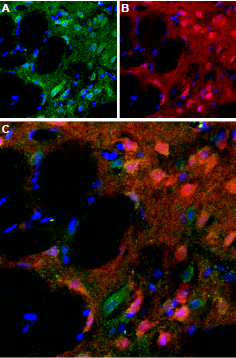Overview
- Peptide EEGWELEGRTENC, corresponding to amino acid residues 199-211 of rat DRD5 (Accession P25115). 2nd extracellular loop.

 Western blot analysis of mouse brain membranes:1. Anti-D5 Dopamine Receptor (extracellular) Antibody (#ADR-005), (1:200).
Western blot analysis of mouse brain membranes:1. Anti-D5 Dopamine Receptor (extracellular) Antibody (#ADR-005), (1:200).
2. Anti-D5 Dopamine Receptor (extracellular) Antibody, preincubated with D5 Dopamine Receptor (extracellular) Blocking Peptide (#BLP-DR005). Western blot analysis of rat striatum membranes:1. Anti-D5 Dopamine Receptor (extracellular) Antibody (#ADR-005), (1:200).
Western blot analysis of rat striatum membranes:1. Anti-D5 Dopamine Receptor (extracellular) Antibody (#ADR-005), (1:200).
2. Anti-D5 Dopamine Receptor (extracellular) Antibody, preincubated with D5 Dopamine Receptor (extracellular) Blocking Peptide (#BLP-DR005).
 Expression of D5 dopamine receptor in rat striatumImmunohistochemical staining of perfusion-fixed rat brain frozen using Anti-D5 Dopamine Receptor (extracellular) Antibody (#ADR-005), (1:100). A. DRD5 (green) appears in a subset of striatal neurons and in the striatal matrix. B. Staining of the same section with calbindin D28k (red), a marker of interneurons. C. Merging the two images demonstrates that DRD5 partially overlaps with the population of calbindin containing striatal interneurons. DAPI is used as the counterstain (blue).
Expression of D5 dopamine receptor in rat striatumImmunohistochemical staining of perfusion-fixed rat brain frozen using Anti-D5 Dopamine Receptor (extracellular) Antibody (#ADR-005), (1:100). A. DRD5 (green) appears in a subset of striatal neurons and in the striatal matrix. B. Staining of the same section with calbindin D28k (red), a marker of interneurons. C. Merging the two images demonstrates that DRD5 partially overlaps with the population of calbindin containing striatal interneurons. DAPI is used as the counterstain (blue).
- Missale, C. et al. (1998) Physiol. Rev. 78, 189.
- Hollon, T.R. et al. (2002) J. Neurosci. 22, 10801.
- Holmes, A. et al. (2004) Neuropharmacology 47, 1117.
The D5 dopamine receptor (D5 receptor) is one of five receptors that mediate the effects of the catecholamine neurotransmitter dopamine. Dopamine regulates a variety of functions including locomotor activity, emotion, positive reinforcement, food intake, and hormone secretion. The dopaminergic system has been extensively studied in the last thirty years mainly because its dysregulation has been linked to several neurological and neuropsychiatric diseases including Parkinson’s disease and Schizophrenia.1
All five dopamine receptors belong to the 7-transmembrane domain, G-protein coupled receptor (GPCR) superfamily.
Historically, the five receptors have been divided into two subfamilies based on pharmacological and structural considerations: the D1-like subfamily (that includes the D1 and D5 subtypes) and the D2-like subfamily (that includes the D2-, D3- and D4 subtypes).1 The D1-like receptors are coupled to Gs-type G proteins and enhance adenylate cyclase activity while the D2-like receptors are coupled to Gi-type G proteins and inhibit adenylate cyclase activity.1
The D5 receptor is widely distributed throughout the brain with the highest expression in the cerebral cortex, hippocampus and striatum. In the periphery, the D5 receptor has been localized in the adrenal cortex, kidney and intestinal tract.
The exact physiological function of the D5 receptor subtype remains poorly understood. Studies with D5 receptor knockout mice have shown no overt alterations in locomotor or cognitive functions. However, knockout mice do develop severe hypertension suggesting a role of the D5 receptor in the modulation of neuronal pathways regulating blood pressure responses.2,3
Application key:
Species reactivity key:
Alomone Labs is pleased to offer a highly specific antibody directed against an epitope located at the 2nd extracellular loop of the rat D5 dopamine receptor. Anti-D5 Dopamine Receptor (extracellular) Antibody (#ADR-005) can be used in western blot analysis and immunohistochemical applications, and recognizes DRD5 from rat and mouse samples.

